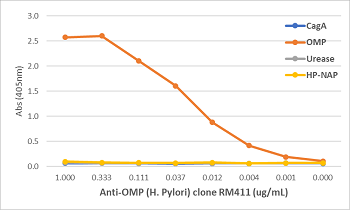anti-OMP Helicobacter pylori Rabbit Monoclonal (RM411)
| Code | Size | Price |
|---|
| REV-31-1297-00-R100 | 100 ul | £455.00 |
Quantity:
Prices exclude any Taxes / VAT
Overview
Antibody Isotype: Rabbit IgG
Antibody Clonality: Recombinant Antibody
Antibody Clone: RM411
Regulatory Status: RUO
Application: Enzyme-Linked Immunosorbent Assay (ELISA)
Shipping:
Blue Ice
Storage:
+4°C
Images
Documents
Further Information
Alternate Names/Synonyms:
H. Pylori Outer Membrane Protein
Concentration:
1 mg/ml
EClass:
32160000
Form (Short):
liquid
Formulation:
Liquid. 50% Glycerol/PBS with 1% BSA and 0.09% sodium azide.
Handling Advice:
Avoid freeze/thaw cycles.
Immunogen:
Proteins purified from Helicobacter pylori.
Long Description:
Recombinant Antibody. This antibody reacts to outer membrane protein of Helicobacter pylori. Applications: ELISA. Source: Rabbit. Liquid. 50% Glycerol/PBS with 1% BSA and 0.09% sodium azide. Helicobacter pylori (H. pylori) is a bacterial class-I carcinogen that specifically colonizes the gastric epithelium of humans as a unique niche, where it can induce inflammatory disorders (e.g. ulceration, chronic gastritis, etc.) and malignant neoplastic diseases (mucosa-associated lymphoid tissue [MALT] lymphoma and gastric cancer). To resist the hostile environment in the stomach, H. pylori has developed highly sophisticated mechanisms to establish life-long infections in the stomach if not therapeutically eradicated. Helicobacter pylori can exist in a number of locations: in the mucus; attached to epithelial cells; or inside of vacuoles in epithelial cells, where it produces adhesins that bind to membrane-associated lipids and carbohydrates to help its adhesion to epithelial cells. Helicobacter pylori contains a hydrogenase enzyme and obtains energy by oxidizing molecular hydrogen produced by other intestinal bacteria. It also excretes urease in order to convert urea into ammonia and bicarbonate which neutralizes the acidic environment of the stomach. Helicobacter pylori OMPs (outer membrane proteins) are involved in Helicobacter pylori adhesion and can cause signal transduction events in host cells. HP-NAP acts as a chemoattractant for nrutrophils, which produce oxygen radicals, cytokines and chemokines, crucial in driving the Th1 inflammation in H. pylori infection.
Package Type:
Vial
Product Description:
Helicobacter pylori (H. pylori) is a bacterial class-I carcinogen that specifically colonizes the gastric epithelium of humans as a unique niche, where it can induce inflammatory disorders (e.g. ulceration, chronic gastritis, etc.) and malignant neoplastic diseases (mucosa-associated lymphoid tissue [MALT] lymphoma and gastric cancer). To resist the hostile environment in the stomach, H. pylori has developed highly sophisticated mechanisms to establish life-long infections in the stomach if not therapeutically eradicated. Helicobacter pylori can exist in a number of locations: in the mucus; attached to epithelial cells; or inside of vacuoles in epithelial cells, where it produces adhesins that bind to membrane-associated lipids and carbohydrates to help its adhesion to epithelial cells. Helicobacter pylori contains a hydrogenase enzyme and obtains energy by oxidizing molecular hydrogen produced by other intestinal bacteria. It also excretes urease in order to convert urea into ammonia and bicarbonate which neutralizes the acidic environment of the stomach. Helicobacter pylori OMPs (outer membrane proteins) are involved in Helicobacter pylori adhesion and can cause signal transduction events in host cells. HP-NAP acts as a chemoattractant for nrutrophils, which produce oxygen radicals, cytokines and chemokines, crucial in driving the Th1 inflammation in H. pylori infection.
Purity:
Protein A purified.
Source / Host:
Rabbit
Specificity:
This antibody reacts to outer membrane protein of Helicobacter pylori.
Transportation:
Non-hazardous
UNSPSC Category:
Primary Antibodies
UNSPSC Number:
12352203
Use & Stability:
Stable for at least 1 year after receipt when stored at -20°C.



